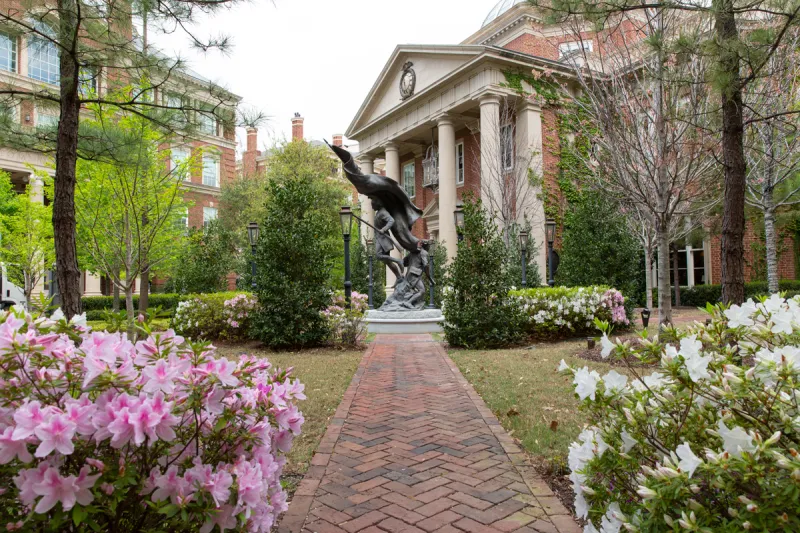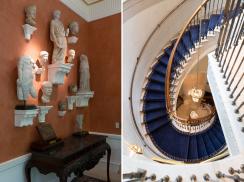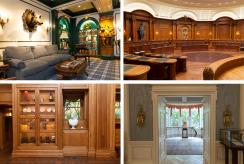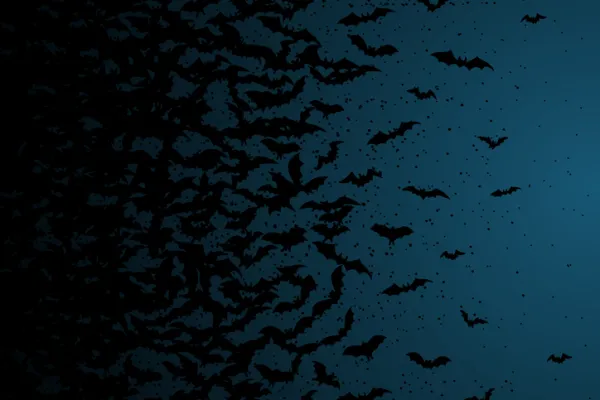
Photographs by Laura Buckman
The armed guards know who doesn’t belong. Take a few steps past the open gates of Dallas’s Old Parkland — a former hospital complex that’s now an exclusive investor enclave — and security will be on you, all southern charm and sidearms.
Walking is a dead giveaway, for one. Texans do not walk outside. Black SUVs with tinted windows and Teslas are the favored modes of transport in and out of Old Parkland. Even the underground garages have become legendary. “There are incredible sculptures in the parking lot,” says one consultant who visits frequently. If you can’t gaze at a masterpiece while your Tesla parks itself, are you even living?
Contrary to rumors, Old Parkland is not technically invite-only. Insiders prefer to describe the community as “curated,” which is a genteel way of saying “exclusive.” Anyone can ask to lease space at Old Parkland, which leads the Dallas market in high-end office property. The board, in turn, is free to reject applicants.
“We’re in the business of renting space, so I don’t want to act too pretentious about it,” says Harlan Crow, the visionary billionaire developer behind Old Parkland. “It’s a business. But there is an additional screen — and a ‘screen’ might be a hard word, but you want people that are really involved. Not just successful business practitioners, but people that care.”
Take hedge fund founder Harlan Korenvaes, for example, Crow says. Korenvaes ran HBK Investments until 2003, when he retired to run his personal fortune. He and a small investment team work from a suite at Old Parkland, one of the many family offices in the complex. Korenvaes serves on the Old Parkland board and is a powerful leader in the Dallas investment scene. As Crow notes, “You really want people that place a high priority on involved citizenship.”
Old Parkland’s selectivity makes it a haven for family offices, which are for personal fortunes so vast that managing them is a full-time job, or several jobs. Family offices tend to be small and secretive, often operating under innocuous names to hide whose money they run. Old Parkland’s magic stems partly from bringing these elusive investors together, and partly from keeping out the shills who’d love to sell them services. Filter out the lawyers and bankers, the thinking goes, or Old Parkland becomes an all-you-can-pitch buffet. Select hedge funds and alternatives shops have been granted access. But to get in, managers need to have an in.
Then comes the interrogation.

“I wish I could do justice to what we did not know was an interview,” says Carpenter, 41. “Harlan sits down and just really wants to understand who we are. ‘What are you doing? Why are you doing it? What’s the point?’ And I’ll never forget: I had on a blue dress shirt. Like three and a half hours in, I remember leaning back, and I was drenched. We hadn’t even looked at the office property yet. And we are getting grilled.”
They never looked at another building. For RedBird, a young firm, getting into Old Parkland has meant access to deals, closer client ties, and a powerful ecosystem for its portfolio companies. A sprinkling of investors on the make keeps Old Parkland lively, Carpenter thinks. “You get a Zach Petrone, who’s 32 with a $100 million hedge fund, here, just like you got Harlan Korenvaes, who built HBK. It’s so cool to have both ends of the spectrum.” Without the whippersnappers, he says, “it’d be kind of like the country club or the old man rich club.”
Old Parkland has its own country club, in fact. A group of tenants got together and converted an unused space above RedBird’s offices into a professional man cave, with a golf simulator, a putting green, a wet bar, and big-screen TVs. They syndicated the start-up costs and collect membership dues from 15 firms. Women at Old Parkland — and there are some — recently built their own lair, with mani-pedi stations and “pink everything.”
Former hedge fund manager Lee Hobson was a founding member of the campus country club, but let his membership lapse after realizing he’d been about twice in two years. His Highside Capital Management returned clients’ money in 2013, and now operates as a family office and seeder to three ex-employees. Crow recruited Hobson as an original tenant. Hobson entered Old Parkland fresh off the hedge fund hustle, and has transitioned to become part of the Korenvaes crowd at Old Parkland. Instead of drinking at the boys’ club, Hobson spends his time at Old Parkland incubating young funds and going to debates. (In one memorable matchup, Alan Dershowitz and Cornel West faced off over Israel.)
Old Parkland’s design — imagine a Founding Fathers pavilion at Epcot Center, but expensive — delights Hobson, a history major. A massive stone tablet inscribed with the U.S. Constitution sits in front of the building, which faces a rotunda inspired by Thomas Jefferson’s design for the University of Virginia. “It’s nirvana,” he says. “I always envision that I’m going to sit in the rocking chairs and think deep thoughts with all these important quotes around me.”
Does he?
Hobson laughs. “We’re always too busy.”

But Old Parkland was built by f*&#-you money for people with f*&#-you money. And that buys the freedom to be fun.
A pig-themed antechamber off a formal debate hall? Why not? Thus sculptures in the parking garage, a Harry Potteresque tavern called the Green Dragon, and murals depicting a campus-themed “The American Experience” inside an indoor basketball court, which converts to a venue for watch parties during big games. A bust of George Washington sits at the foot of the stairs to Crow’s personal office. On the wall of his office is a banner for Faber College, the fictitious party school from Animal House. “Those weren’t my best years,” Crow says, wincing, of his time at the University of Texas at Austin. “I was terrible. I used to joke that anything over a C was inefficient. It’s okay; I’m here.”
Quirkiness hasn’t hurt Old Parkland’s appeal among serious and important people. Indeed, they’re drawn to it. President George W. Bush has leased the sixth floor of a new building under construction for his private offices, says Cathy Golden, the campus’s general manager. The security, one imagines, will get even tighter.
When Golden came aboard in 2013, Old Parkland was just “a giant hole in the ground,” she says. “This entire area was a little, well, less developed when we purchased the property, which was fenced in and abandoned.” Dallas’s first hospital, Parkland, moved to the site in the 1890s, and during World War II it housed recovering soldiers. After Parkland Hospital relocated in 1954, the old site fell into disrepair. When President John F. Kennedy was shot in 1963, he was taken to Parkland’s new location, where he was pronounced dead.
The redevelopment cost about $300 million, none of which came from investors. Harlan Crow is a second-generation real estate magnate and head of Crow Holdings, but he chose to fund this project himself. “We’ve been lucky to enjoy some financial success, so we really built the project without financing,” he says in an interview at his private office, a space awash in light, books, and fireplaces. “We ultimately did put some mortgages on the place because interest rates are what they are — it would be almost irresponsible not to do that. But when we built it, we just built it for cash.” That decision, he admits, was “not normal. And it might not even be smart. But I’ve done so many things that weren’t smart.”
Old Parkland makes money, but that was never the point. “I think there’s financial return, and then there’s something else,” says Crow. “Sometimes I call it cosmic return, and that’s really a bullshit term. But there are benefits that can come from an investment that aren’t numerical. You can’t underwrite that, and all the smart people that read Institutional Investor would think I’m an idiot. But one of the nice things about being 65 is that you don’t care.”





